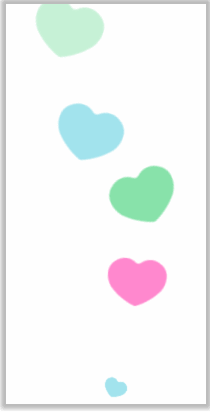(<3kb) 💖Bubble hearts animation.(Canvas 实现直播间点赞动画)
- Let images bubble in canvas, like hearts (etc).
- It's a familiar animation in live room.
- Live Demo
$ npm install --save-dev bubble-hearts
let stage = new BubbleHearts();let canvas = stage.canvas;
let context = stage.context;
canvas.width = 200;
canvas.height = 400;
canvas.style['width'] = '200px';
canvas.style['height'] = '400px';document.body.appendChild(canvas);let image = new Image;
image.onload = () => {
stage.bubble(image);
};
image.src = src;stage.bubble( image : Image/Canvas, duration : Number, handler : Function )
| Param | Type | Required | Default | Description |
|---|---|---|---|---|
| image | Image/Canvas | * | - | Let this image bubbles in canvas. |
| duration | Number | - | 3000 | The duration of animation. |
| handler | Function | - | @see handler | The handler of animation. |
handler( lifespan : Number )
| Param | Type | Description |
|---|---|---|
| lifespan | Number | From 1 to 0; 1 means full live; 0 means over. |
- default handler
/**
* Create a default Render
* @param {Canvas} canvas canvas
* @param {Context} context context
* @return {Function} handler
*/
function createRender ( image, canvas, context ) {
const zoomInStage = random.uniformDiscrete(89, 91) / 100;
const zoomInRest = 1 - zoomInStage;
const basicScale = (random.uniformDiscrete(45, 60) + random.uniformDiscrete(45, 60)) / 100;
let getScale = ( lifespan ) => {
if (lifespan > zoomInStage) {
return Math.max(((1 - lifespan) / zoomInRest).toFixed(2), 0.1) * basicScale;
} else {
return basicScale;
}
};
const basicRotate = random.uniformDiscrete(-30, 30);
let getRotate = ( lifespan ) => {
return basicRotate;
};
const offset = 10;
const basicTranslateX = canvas.width / 2 + random.uniformDiscrete(-offset, offset);
const amplitude = (canvas.width - Math.sqrt(Math.pow(image.width, 2) + Math.pow(image.height, 2))) / 2 - offset;
const wave = random.uniformDiscrete(amplitude * 0.8, amplitude) * (random.uniformDiscrete(0, 1) ? 1 : -1);
const frequency = random.uniformDiscrete(250, 400);
let getTranslateX = ( lifespan ) => {
if (lifespan > zoomInStage) {
return basicTranslateX;
} else {
return basicTranslateX + wave * Math.sin(frequency * (zoomInStage - lifespan) * Math.PI / 180);
}
};
let getTranslateY = ( lifespan ) => {
return image.height / 2 + (canvas.height - image.height / 2) * lifespan;
};
const fadeOutStage = random.uniformDiscrete(14, 18) / 100;
let getAlpha = ( lifespan ) => {
if (lifespan > fadeOutStage) {
return 1;
} else {
return 1 - ((fadeOutStage - lifespan) / fadeOutStage).toFixed(2);
}
};
return ( lifespan ) => {
if (lifespan >= 0) {
let scale = getScale(lifespan);
let rotate = getRotate(lifespan);
let translateX = getTranslateX(lifespan);
let translateY = getTranslateY(lifespan);
context.translate(translateX, translateY);
context.scale(scale, scale);
context.rotate(rotate * Math.PI / 180);
context.globalAlpha = getAlpha(lifespan);
context.drawImage(
image,
-image.width / 2,
-image.height / 2,
image.width,
image.height
);
context.rotate(-rotate * Math.PI / 180);
context.scale(1 / scale, 1 / scale);
context.translate(-translateX, -translateY);
context.globalAlpha = 1;
} else {
return true;
}
};
}- simple custom example
stage.bubble(image, 3000, function ( lifespan ) {
// You got its lifespan, and from 1 to 0
if (lifespan >= 0) {
stage.context.drawImage(
image,
(canvas.width - image.width) / 2,
// lifespan control its positionY, so that it will look like fly up
(canvas.height - image.height) * lifespan,
image.width,
image.height
);
} else {
// Return true to free the memory
return true;
}
});- lifespan from
1to0, and go on to be negative. - handler function repeats again and again to
drawImage. return trueis a flag to tell iterator to remove this handler, and stop repeating this handler again.
MIT




